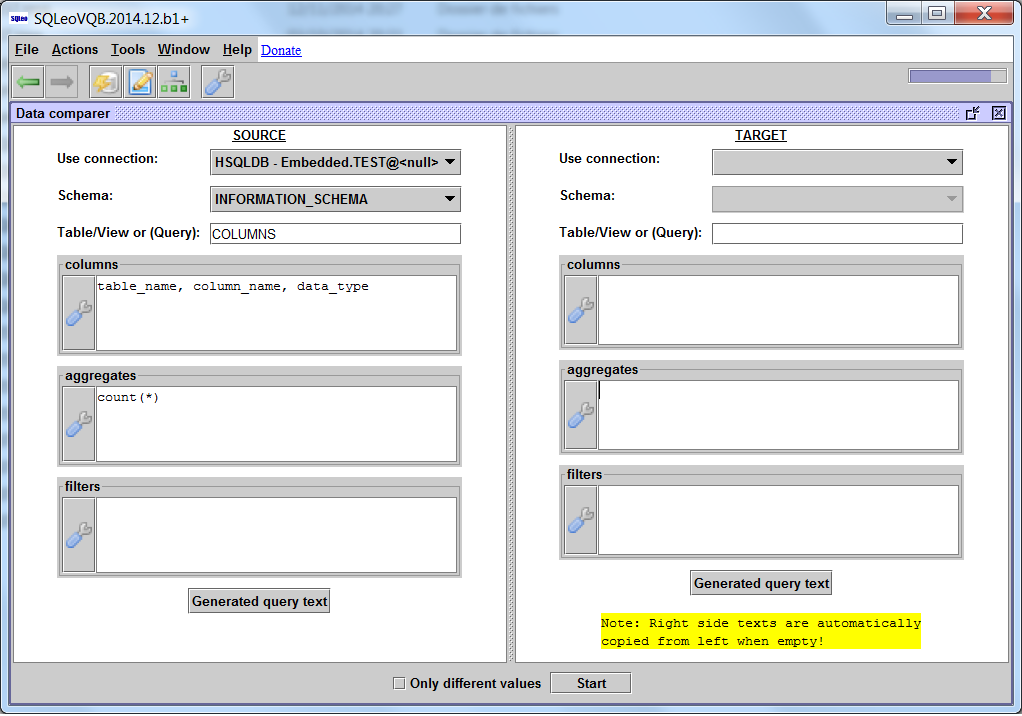
- #Ow to check the back history in dbvisualizer how to#
- #Ow to check the back history in dbvisualizer code#
You can now click on ' Connect' to connect to the embedded database. Screenshot: Connecting to the Embedded Database Select the connection from the list on the left hand side. Refer to the example screenshot above if you are unsure Click on ' Finish' to complete the setup.  Click on Test Connection to verify that the details are correct. Browse to your directory if you are going to connect to your production database (crucible is shutdown), or Browse to your expanded > directory that was created when you unzipped the backup file you made (if you just want to run some queries against your data).
Click on Test Connection to verify that the details are correct. Browse to your directory if you are going to connect to your production database (crucible is shutdown), or Browse to your expanded > directory that was created when you unzipped the backup file you made (if you just want to run some queries against your data). 
Browse to FISHEYE_HOME/lib directory where the hsqldb*.jar file is located, eg /Users/pkamal/crucible-1.6.6/lib/hsqldb-1.8.0.10.jar.From the drop down list select HSQLDB Embedded.Screenshot: Entering a Name for the Connection Enter an identifiable name for the connection.Screenshot: Opening the Connection Wizard
#Ow to check the back history in dbvisualizer code#
In SQL Server, you can do it using the central management server with the combination of SSIS, SSRS tools however it requires a good level of knowledge of the development of the information using these code but again if requirement changes, we need to make changes at all places to reflect the change.Ensure you create a backup (Administration > Backup) of your data before attempting any modifications. In such a case, we need a central place from which we can get any backup information for any database in the instance. We might report backup failures or backup reports to the management. We might be having different kinds of environments having different database needs, and if we have a large database environment, it becomes difficult to get this data. We need to write the code and get the data accordingly. It does become difficult to get the backup information each time based on the requirement. In my test instance, you can see many databases having no database backups: For example, we can get the backup history from yesterday using the below query: We need to join these multiple tables to get the relevant backup information.
Type: We can get the backup type using this column value. Machine_name: we can get the name of the machine from which we took the backup. Server_name: It shows the instance name of the server. Backup_start_date and backup_finish_date: It gives the backup start and ends time. It can help us to identify the backups after a particular LSN or preparing a restoration plan for a database Fist_lsn,last_lsn and database_backup_lsn: We get the backup LSN information from this column.  User_name: We can get a user who executed this backup from this column. Name: backup SQL database set description. Type ,database_name ,server_name ,machine_name from backupset Select name, user_name ,first_lsn ,last_lsn ,database_backup_lsn ,backup_start_date ,backup_finish_date , In this table, we get the information about the logical and physical backup SQL database file name along with the device type in which backup was taken: We can have following values for this.īackup_size: It gives the backup SQL database size in bytes.ĭifferential_base_lsn: SQL Server takes a differential backup for the extents having LSN greater than differential_base_lsn. State: It gives the state information of particular file. Logical_name: Logical name of the database file. We do not have any filegroup for the log file therefore this column can contain NULL value.īacked_up_page_count: It shows the page count backed up.įile_type: We can get the file type using this field. In the following image, we can see essential columns of this table:įilegroup_name: It shows the filegroup name of the data or log file. This table contains the row for each data or log file of the database for which we executed the backup SQL database. In this article, we will understand the way to retrieve the database backup history to meet these critical business requirements.īelow are tables in the msdb database for the database backups.
User_name: We can get a user who executed this backup from this column. Name: backup SQL database set description. Type ,database_name ,server_name ,machine_name from backupset Select name, user_name ,first_lsn ,last_lsn ,database_backup_lsn ,backup_start_date ,backup_finish_date , In this table, we get the information about the logical and physical backup SQL database file name along with the device type in which backup was taken: We can have following values for this.īackup_size: It gives the backup SQL database size in bytes.ĭifferential_base_lsn: SQL Server takes a differential backup for the extents having LSN greater than differential_base_lsn. State: It gives the state information of particular file. Logical_name: Logical name of the database file. We do not have any filegroup for the log file therefore this column can contain NULL value.īacked_up_page_count: It shows the page count backed up.įile_type: We can get the file type using this field. In the following image, we can see essential columns of this table:įilegroup_name: It shows the filegroup name of the data or log file. This table contains the row for each data or log file of the database for which we executed the backup SQL database. In this article, we will understand the way to retrieve the database backup history to meet these critical business requirements.īelow are tables in the msdb database for the database backups. #Ow to check the back history in dbvisualizer how to#
In the case of any disaster, we must know exactly how to get the data from this internal table and prepare the restoration plan accordingly. We might be taking different kinds of backups to the main minimum restoration time. SQL Server maintains a backup history in the system database msdb. Such policies help to recover the database with minimum loss of the data and minimum downtime. It is essential for each organization to define the backup policy in its environment. This article will review how to get information on your backup SQL database history, including the metadata in MSDB that can be queried, as well as value-added tools and features to group, sort, report, and export this critical information







 0 kommentar(er)
0 kommentar(er)
